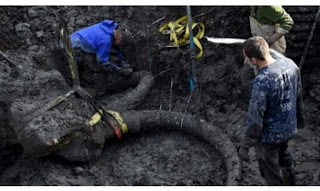Woolly mammoth
***Farmer finds woolly mammoth bones in Michigan field, stashed by Ancient Natives***
Though buried for thousands of years, the partial skeleton of a woolly mammoth found in Lima Township indicates that the animal actually ended up on the dinner plate of a Native American.
“It’s too early to tell how it died but the skeleton showed signs of butchering,” said Professor Dan Fisher of the Museum of Paleontology at the University of Michigan.
The remains were found by James Bristle, on the soy bean farm that was owned by him. When he first encountered the remains, he thought it was an old fence post, but it turned out to be about 20 percent of a woolly mammoth, including the skull, jaw, vertebrae and ribs, that died between 11,000 and 15,000 years ago.
The site holds “excellent evidence of human activity,” Fisher said. “We think that humans were here and may have butchered and stashed the meat so that they could come back later for it.”
Mammoths and mastodons — another extinct elephant-like species — once wandered North America before they disappeared around 11,700 years ago. In Michigan the bones of about 300 mastodons and 30 mammoths were found over the years, Fisher said.
For this area, it was common to store mammoth meat in ponds for later use, according to experts.
Proof supporting this theory involves three boulders of basketball size found next to the remains of a mammoth. It could have been the boulders that were used to anchor the dead animal in a lake.
The first bones were uncovered when Bristle was installing drainage pipe at a low spot in a wheat field surrounded by soybeans.
“We didn’t know what it was, but we knew it was certainly a lot bigger than a cow bone,” said Bristle, who admitted the discovery to be both thrilling and destructive.
But he said he’s confident he made the right choice.
“When my 5-year-old grandson came over and saw the pelvis, he just stood there wide open and stared with his eyes. He was in awe,” said Bristle. ‘’ So I think this was the best thing to do.”
One day, Bristle gave the UM team back the remains. They worked from early morning until almost sunset, with the aid of James Bollinger of Chelsea’s Bollinger Sanitation and Excavating, who donated his time.
Bollinger brought in equipment to help uncover the ancient creature.
University researchers cleaned and inspected the bones for cut marks which suggested human activity, Fisher said. Bone study will shed light on the arrival of humans in the Americas, which became a subject of discussion among archeologists.
https://nativestories.net/farmer-finds-woolly-mammoth-bones-in-michigan-field-stashed-by-ancient-natives/




Comments
Post a Comment